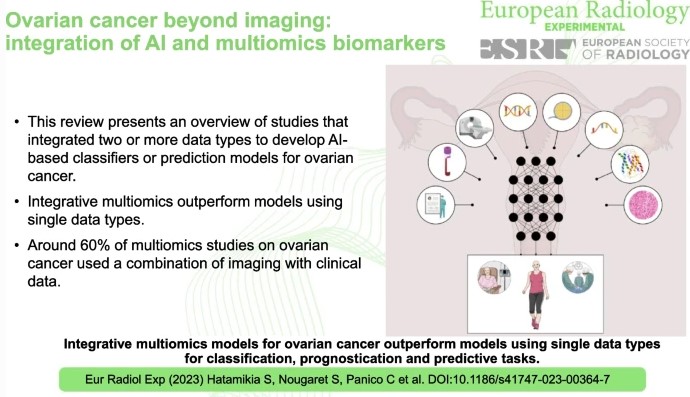Ovarian cancer, often referred to as the “silent killer”, tends to show inconspicuous symptoms in the early stages, making timely diagnosis difficult. Detecting ovarian cancer at an early stage significantly increases the chances of effective treatment and therefore the chances of survival. This review study has shown that AI-based tools that rely on the integration of multi-omics data perform better than single-omics datasets in classifying adnexal lesions and predicting ovarian cancer outcomes. Integration of radiomics and clinical information or integration of radiomics with other data types, such as histopathologic, genomic, and clinicopathologic data, outperformed models using radiomics or clinical models or other data types alone. In addition, the integration of genomics and epigenomics, transcriptomics, and other omics data, improved the results compared to single-omics data.
Although the achieved results in this field are promising, I believe that several limitations need to be addressed in future research. The research community should describe their AI methods in sufficient detail to ensure that the results are reproducible, otherwise, it would be impossible to compare the results of different developments between various centers and research groups. Secure data-sharing strategies, such as the use of a federated setup and independent datasets for validation of developed methods, should be used more widely to ensure the development of highly generalizable models and facilitate translation to the clinic. Sharing of developed codes and software in public repositories should also be utilized to enable independent reproduction of results and comparison between the results of newly developed algorithms and existing methods. Addressing these points can promote higher quality and generalizable research and better knowledge transfer in the field of oncology and AI.
Key points
- This review presents studies using multiomics and artificial intelligence in ovarian cancer.
- Current literature proves that integrative multiomics outperform models using single data types.
- Around 60% of studies used a combination of imaging with clinical data.
- The combination of genomics and transcriptomics with imaging data was infrequently used.
Article: Ovarian cancer beyond imaging: integration of AI and multiomics biomarkers
Authors: Sepideh Hatamikia, Stephanie Nougaret, Camilla Panico, Giacomo Avesani, Camilla Nero, Luca Boldrini, Evis Sala & Ramona Woitek













